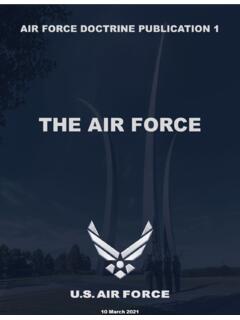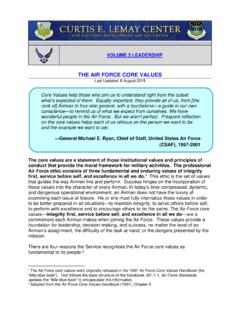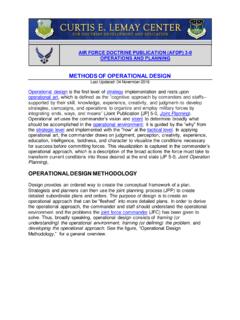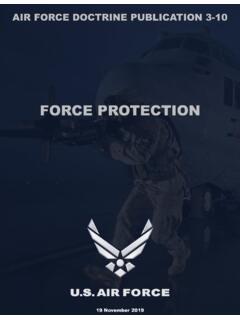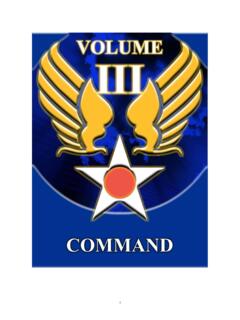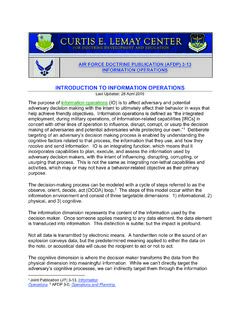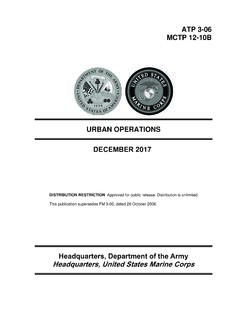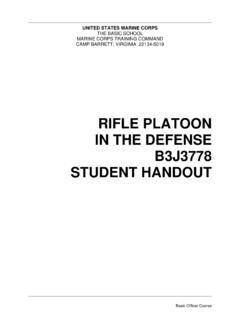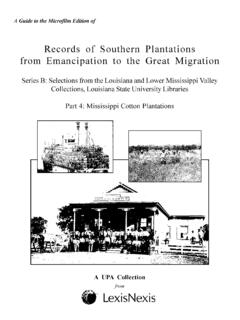Transcription of COUNTERAIR OPERATIONS - U.S. Air Force Doctrine
1 AIR Force Doctrine PUBLICATION 3-01 COUNTERAIR OPERATIONS6 September 20192 INTRODUCTION TO COUNTERAIR OPERATIONS Last Updated: 6 September 2019 COUNTERAIR OPERATIONS Doctrine is constantly evolving. It should guide us to effectively organize and employ COUNTERAIR capabilities against peer and near-peer competitors. As we continuously improve our airpower capabilities and capacities in air, space, and cyberspace, our ability to improve COUNTERAIR OPERATIONS and incorporate new concepts and technologies will identify new best practices in COUNTERAIR Doctrine . Control of the air provides the joint Force with freedom of actio n while reducing vulnerability to enemy air and missile attacks. Peer and near-peer competitors have and are developing advanced aircraft, cruise and ballistic missiles, hypersonic glide vehicles, and sophisticated air and missile defenses.
2 Examples of these developments include Russian Sukhoi-57 and Chinese Chengdu J-20 fifth generation fighters, Russian Iskander and Chinese DF-26 ballistic missiles, and Russian S-400 and Chinese HQ-9 air and missile defense systems. Ir an and North Korea have significant and constantly improving ballistic missile forces protected by integrated air defense systems. These capabilities, supported by peer and near-peer cyberspace and space advancements, present growing challenges to the joint Force s ability to achieve control of the air. The Air Force brings resources, capabilities, and experience to the joint Force to help achieve that control. Clearly defined domains help identify the conditions and capabilities under which systems and personnel conduct OPERATIONS , but do not mandate or imply command relationships.
3 T he air domain is the atmosphere, beginning at the Earth s surface, extending to the altitude where its effects upon OPERATIONS become negligible. 1 Control of the air is normally one of the first priorities of the joint Force . This is especially important whenever the enemy is capable of threatening friendly forces from the air or inhibiting a joint Force commander s (JFC s) ability to conduct OPERATIONS . The COUNTERAIR mission integrates offensive and defensive OPERATIONS to attain and maintain the JFC s desired degrees of control of the air and of protection by neutralizing or destroying enemy aircraft and missiles before, during, and after launch. COUNTERAIR OPERATIONS help ensure freedom to maneuver, freedom to attack, and freedom from attack.
4 1 J oint Publication (JP) 3-30, Joint Air OPERATIONS . AIR Force Doctrine PUBLICATION (AFDP) 3-01 COUNTERAIR OPERATIONS 3 COUNTERAIR is directed at enemy forces that directly or indirectly challenge control of the air. These forces may include but are not limited to: aircraft, surface-to-air missiles, ballistic missiles, airfields, fuel, command and control facilities, and network links. Airmen integrate capabilities from all components to conduct intensive and continuous COUNTERAIR OPERATIONS aimed at gaining varying degrees of control of the air at the time and place of their choosing. Joint Doctrine provides broad guidance for countering air and missile threats (see JP 3-01, Countering Air and Missile Threats), but does not describe the full spectrum of control of the air, as this publication does.
5 4 COUNTERAIR OPERATIONS Last Updated: 6 September 2019 The COUNTERAIR mission integrates offensive and defensive OPERATIONS to attain and maintain a desired degree of control of the air and of protection by neutralizing or destroying enemy aircraft and missiles, alo ng with threats to air OPERATIONS from other domains. COUNTERAIR OPERATIONS are conducted across all domains and determine the level or degree of control of the air. Control of t he air describes a level of influence in th e air domain relative to that of an adversary, and is typically categorized as parity, superiority, or supremacy. The degree of control lies within a spectrum that can be enjoyed by any combatant. This can range from a parity (or neutral) situation, where neither adversary can claim control over the other, to air superiority, to air supremacy over an entire operational area, all depending upon the situation and the joint Force commander s (JFC s) concept of OPERATIONS .
6 The figure, Control of the Air Continuum, defines the degrees of operational area control and illustrates their relationship. The desired degree of control of the air is t ypically at least air superiority to enable the successful execution of joint OPERATIONS such as strategic attack, interdiction, and close air support. In a peer or near-peer conflict, air superiority may not be able to be achieved in all places or at all t imes. Normally, COUNTERAIR OPERATIONS are classified as offensive or defensive. However, airpower s inherent flexibility allows missions and aircraft to shift from defensive to offensive (or vice versa) to adapt to changing conditions in the operational environment. COUNTERAIR OPERATIONS can be conducted across the tactical, operational, and strategic levels of war by any component or element of the joint Force .
7 OPERATIONS may be conducted over and in enemy, friendly, and international airspace, land, and waters; as well as in space and cyberspace. They range from seeking out and destroying the enemy s aircraft (manned and unmanned) and missiles (air-to-air, surface-to-air, cruise, and ballistic), through measures designed to minimize the effectiveness of those systems, to countering efforts to contest control of the air through use of other domains such as space and cyberspace. The JFC s objectives and desired effects determine when, where, and how these OPERATIONS are conducted to gain the desired degree of control of the air. AIR Force Doctrine PUBLICATION (AFDP) 3-01 COUNTERAIR OPERATIONS5 Control of the Air Continuum Air parity. Air parity is described as a condition in which no Force has control ofthe air.
8 This represents a situation in which both friendly and adversary land,maritime, and air OPERATIONS may encounter significant interference by the opposingforce. Parity is not a standoff, nor does it mean aerial maneuver or ballistic missileoperations have halted. On the contrary, parity may be typified by fleeting, intenselycontested battles at critical points during an operation with maximum effort exertedbetween combatants in their attempt to achieve some level of favorable control. Air superiority. Air superiority is that degree of control of the air by one forcethat permits the conduct of its OPERATIONS at a given time and place withoutprohibitive interference from air and missile threats (Joint Publication [JP] 3-01,Countering Air and Missile Threats).
9 Air superiority may be localized in space(horizontally and vertically) and in time, or it may be broad and enduring. Air supremacy. Air supremacy is that degree of control of the air wherein theopposing Force is incapable of effective interference within the operationalarea using air and missile threats (JP 3-01, Countering Air and Missile Threats).Air supremacy may be localized in space (horizontally and vertically) and in time, orit may be broad and enduring. This is the highest level of control of the air that airforces can pursue. Air supremacy may be difficult to achieve in a peer or of the air hinges on preventing prohibitive or effective interference to friendly forces in the air domain from enemy forces, which would prevent friendly forces from creating their desired effects.
10 Air supremacy prevents effective interference, which does 6 not mean no interference exists, but any attempted interference can be easily countered or should be so negligible as to have little or no effect on OPERATIONS . While air supremacy is most desirable, it may not be operationally feasible. Air superiority, even local or mission-specific, may provide sufficient freedom of action to create desired effects. Therefore, commanders should determine the minimum level of control of the air required to accomplish their mission and assign an appropriate level of effort to achieve it. In modern warfare, parity is often not recognized at the moment it exists. It is more easily identified when viewed in a historical context as the point in time just prior to when momentum swung to favor one combat Force over another.
